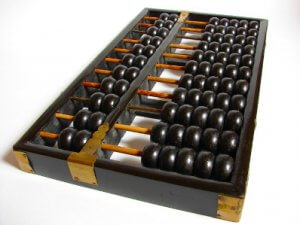How to Make and Use Math Manipulatives for Basic Operations

This is the first post in a series of posts about using math manipulatives.
Easy, Inexpensive Ideas for Teaching Adding, Subtracting, Multiplication and Division
To introduce a child to counting and single-digit addition and subtraction with manipulatives, begin with a large quantity of small items you probably have lying around the house. Pennies, beans, beads, buttons, peanuts, Cheerios, pretzel sticks, M&M's, or Legos, or any such items will work well for this purpose. Some children prefer items that are more fun and colorful such as Amazon's animal counters.
Set a bowl of these items beside the child whenever working on math. Use the pieces to practice counting. When working on addition problems, write the problem in big numbers on a piece of paper. Allow the child to count out and lay the manipulatives underneath the numbers, then combine them and recount for the answer. When working on subtraction problems, have the child count out the larger number, then remove manipulatives to come to the answer.
When the child begins to learn place values, bundle 10 of your item up in a small piece of plastic wrap, and tie off with a twist tie or rubber band. Use these bundles to represent the 10's column, and use loose pieces for the 1's column.
Let's say the child is adding 27 and 15. Write the problem on a piece of paper. Have the child select two bundles and seven individual pieces to represent 27, and one bundle and five individual pieces to represent 15. In adding the one's column, 5 + 7 = 12. Have the child bundle 10 of the 12 and carry the bundle over to the ten's column, and then add how many bundles of 10 there are. This will help the child grasp the concept of columns, place values and "carrying."
When subtracting, just break apart the bundles of 10 in the ten when they are to be "borrowed" by the one's column. Eventually, you can bundle ten of the 10-packs up in a sandwich baggie to represent the 100's column, and so on.
Once children move on to multiplication and division, add some old muffin pans to your math manipulatives collection to use with your original counting pieces. What you are really looking for is to work with a number of compartments, so alternately, you could use a pill organizer or box for organizing beads or nails or any small craft items.
For multiplication, use the separate compartments to make "sets." For example, if the problem were 6 X 3, have the child place three manipulative pieces in six different compartments and count them all to get the total. As the child advances, you could use the bundles of tens as well in this way.
If trying to solve a division problem, such as 12/4, give them twelve manipulatives and show them how to drop four pieces into each compartment until the twelve have been divided evenly-- the amount of compartments needed is the answer. When numbers do not divide evenly, the leftover pieces are the remainder.
 One great math tool to have around is an abacus - an ancient Chinese "calculator" that uses beads for figuring. You can make your own simple model with a wooden 8x10 picture frame, yarn, and some beads (don't use beads that are so tiny they are difficult to string or manipulate- they should be easy to grasp and move with ease across the yarn).
One great math tool to have around is an abacus - an ancient Chinese "calculator" that uses beads for figuring. You can make your own simple model with a wooden 8x10 picture frame, yarn, and some beads (don't use beads that are so tiny they are difficult to string or manipulate- they should be easy to grasp and move with ease across the yarn).
Begin by tying 10 pieces of the yarn securely onto one side of the frame. If you like, secure them with a bit of craft glue so they don't slide around. String 10 beads on each piece of yarn, pull it taught and tie each string to the opposite side of the frame, securing with more glue if necessary. The beads can now be moved back and forth for calculating, either by counting each bead as an individual or as designating rows with different place values.
For those of you who are less crafty, Amazon has a zillion different options. Personally, I like this one quite a bit.
Whether in the classroom, homeschooling, or just practicing to improve skills, these math manipulatives are a great, inexpensive way to help children grasp the various basic math operations.







Leave a Reply